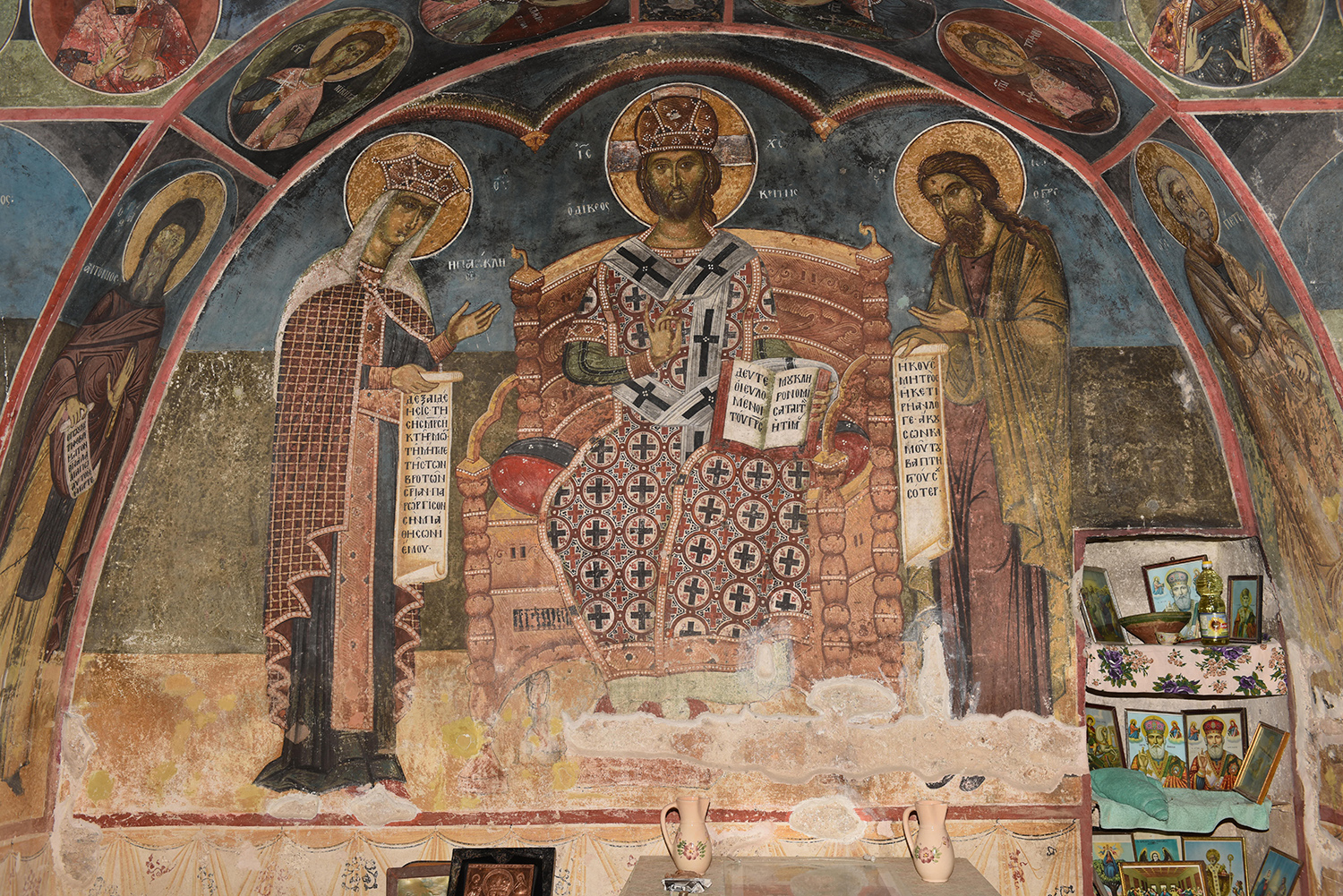
Wall paintings in the naos of the St Nicholas Church, Toplički Monastery
Several groups of icon-painters came from the area of the Mountain of Gramos and worked in a large geographic area in the 16th century and the 17th century as an echo of their art is clearly perceivable in the early 18th century as well. Currently, the researchers have distinguished more than twenty masters from the villages of Linotopi, Zerma, Gramosta and more than one hundred works – mural ensembles, icons, wood carvings – preserved on the territory of today’s Greece, Albania and Macedonia. The work of these icon-painters has not yet been studied systematically because it was not until the recent decades that the specialists have started to pay more thorough attention to this material. In the publications so far there have been contradictions in the attribution of the painting in individual monuments to one or another icon-painter from these populated areas known by his name or another; a number of murals and icons related to this topic have not yet been studied and published but one can nevertheless outline some basic aspects and figures important for the artistic life on the Balkans.
The masters from the settlements in the Mountain of Gramos are ones of peasant origin, most commonly organized into family ateliers and traveling from church to church while practicing their craft. The main difference between them and the well-known 16th-century family icon-painting teams such as the ones of Theophanes and his sons or the Kondaris brothers, is the latter’s urban origin because of which they are characterized by a different and, naturally, higher level of education and training in an environment with higher artistic tastes and requirements. The icon-painters from Linotopi and Gramosta learned their trade inside the family whereupon the painting was viewed as one of the means of livelihood and a craft whose practice requires some special abilities but it cannot be compared to the artistic heights of the 16th century. As a whole, there is no consistency in the work of the icon-painters from different family associations from the two villages: they differ in terms of their skills and stylistic preferences. On the other hand, in some cases there are similarities in the work of individual icon-painting teams from Gramosta and Linotopi showing mutual influences and relations.
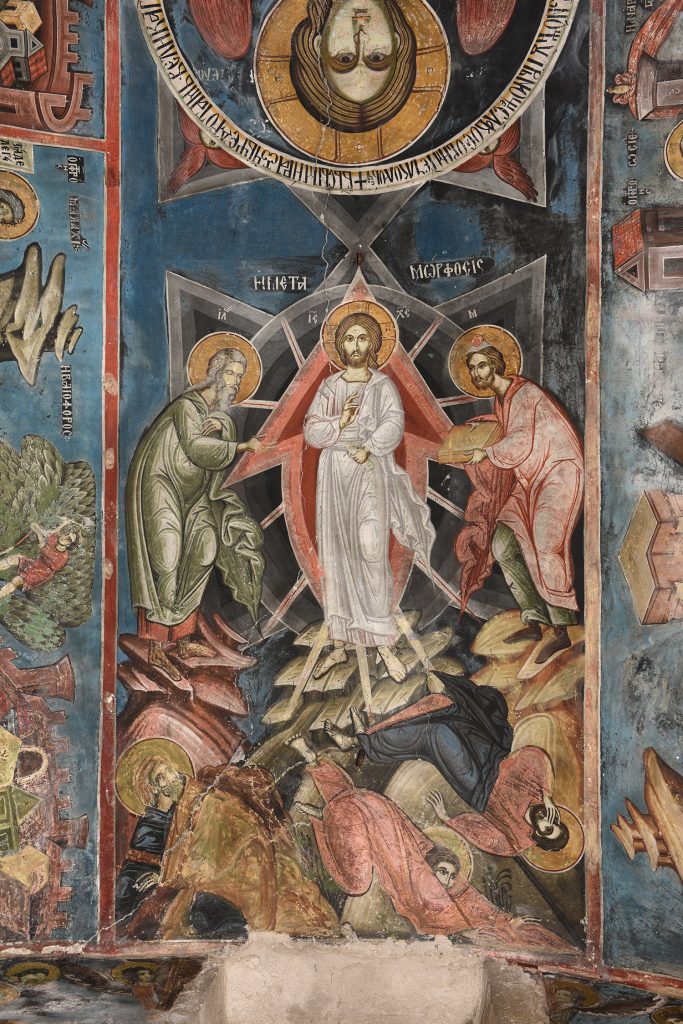
Wall paintings from the barrel vault in the naos of the St Nicholas Church, Toplički Monastery
In the cases where they did sign their works these masters often mentioned where they came from. Indeed today we would know almost nothing about the history of the populated areas in the Mountain of Gramos were it not for the dedication inscriptions preserved in the churches where these masters worked. Today, the village of Gramosta is very sparsely populated and Linotopi does not exist; its ruins are situated at the northern foot of the Mountain of Gramos, on the right bank of the Bistritsa River. The area of these settlements was under the jurisdiction of the metropolitan center of the town of Kastoria. It is assumed that they were founded soon after the Ottoman conquest when the Christian population sought refuge in the mountains. Initially, they were Vlach settlements as in the 17th century and the 18th century they enjoyed great prosperity; there are data of the existence of a school in Linotopi from this period. The village must have existed before 1570, the year when the icon-painter Nikolaos of Linotopi signed his name at the church in the village of Palatitsia near the city of Veria. In 1770s, a number of villages in the area were plundered and devastated, Gramosta and Linotopi among them, and after the cataclysms the life in these areas did not recovered in its former scale.
From the information preserved in the inscriptions on murals and icons one can restore a picture which shows that the icon-painters of Gramosta and Linotopi developed artistic activity in the period 16th-18th century. According to the historical sources and signed works they engaged in artistic processing of gold and silver, icon painting and gilding and church wood carvings in addition to making murals. They were often hired to make the icons for a certain church as well as to make its mural decoration simultaneously or several years thereafter. The work of these icon-painters is characterized by eclecticism, it shows their knowledge of the iconographic solutions of the Cretans, the works produced in Kastoria and the region as well as a more palpable influence of the painting of the Epirus school in the person of Frangos Katelanos and the Kondaris brothers but these all were based on a more primitive approach to the drawing of the images where the importance of the line prevails. It seems that the abilities to convey volumes are more limited, there is certain crudeness in their attempt to convey the movement of the figures which creates the impression of clumsiness. As a whole the specialists think that this direction is characterized by conservatism and greater proximity to painting as a craft. It seems that both the abilities and the aspirations of these icon-painters differ from the high artistic achievements associated with the names of 16th-century masters such as Theophanes the Cretan, Frangos Katelanos and the Kondaris brothers or the icon-painter Onuphrius. They do not only lack a homogeneous style, the poorer artists among the Linotopi masters allow disproportions, asymmetries in compositions, lack of plasticity in the figures.
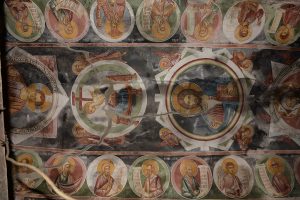
Wall paintings from the barrel vault of the naos of St Athanasius Church, Shishevo village
Among the leading icon-painters of the Archbishopric of Ohrid in the second quarter of the 16th century is Ioan Teodorov of Gramosta. His most significant signed work preserved today are the murals at the Church of St. Nicholas in the Toplički monastery which were painted on two occasions in the period 1534-37. The icons made by him for the same monastery in 1543 are also remarkable. Researchers have traced out the influence of Ioan Teodorov over the next three decades when his followers left a number of icon-painting and mural works, whose characteristics are close to his work, in the area of Ohrid, Struga and Skopje, among them the murals in the narthex of the monastery church of St. Andrew on the Treska River (1559/60), in the Church of St. Athanasius in the village of Shishevo (1565), the Church of St. Saviour in Dobri Dol (1576) and others.
The icon-painters Michael and Constantine, who worked in 1603/4 in the Katholikon of the Monastery of the Assumption Divrovouni near the village of Divri in Eastern Albania, also come from Gramosta. There have been some hypotheses stated in the literature that the same icon-painters authored the murals in some of the churches in Nessebar but the more thorough examination of these monuments in situ shows that it is more likely that they were not created by the same icon-painting team. However, there are a number of similarities which speaks of their belonging to a common tradition or place of education. The names of some other icon-painters of Gramosta from the second quarter of the 17th century have been preserved: Dimitrios and his son Ioannis Skoutaris, who signed in the Church of St. Apostles Molivdoskepastos (1645), district of Ioannina as well as the brothers Dimitrios and Georgios of Gramosta.
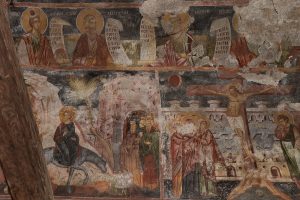
Wall paintings from the Holy Saviour Church, Dobri Dol village
The earliest representative of the icon-painters of the village of Linotopi who is known today, Nikolaos, left his name in the murals at the Church of St. Demetrius in the village of Palatitsia (1570), near Veria. The specialists have observed that in his work this icon-painter was also influenced by the heritage of Ioan Teodorov of Gramosta. Nikolaos’ formation as a painter did not take place in Linotopi – it is assumed that before that he worked in what is today’s Serbia or Macedonia. Among the reasons for such an opinion is the inclusion of two saints into the painting program of the church in Palatitsia: St. Sava of Serbia and St. George of Kratovo, who are especially honored on the territory of the Patriarchate of Peć and are not typical of the Greek painting of the time. In the studies there is also a hypothesis that in addition to being the team leader Nikolaos was also the founder of a family of icon-painters in Linotopi, it is no chance that the same name appears often among the next generations of icon-painters from that village.
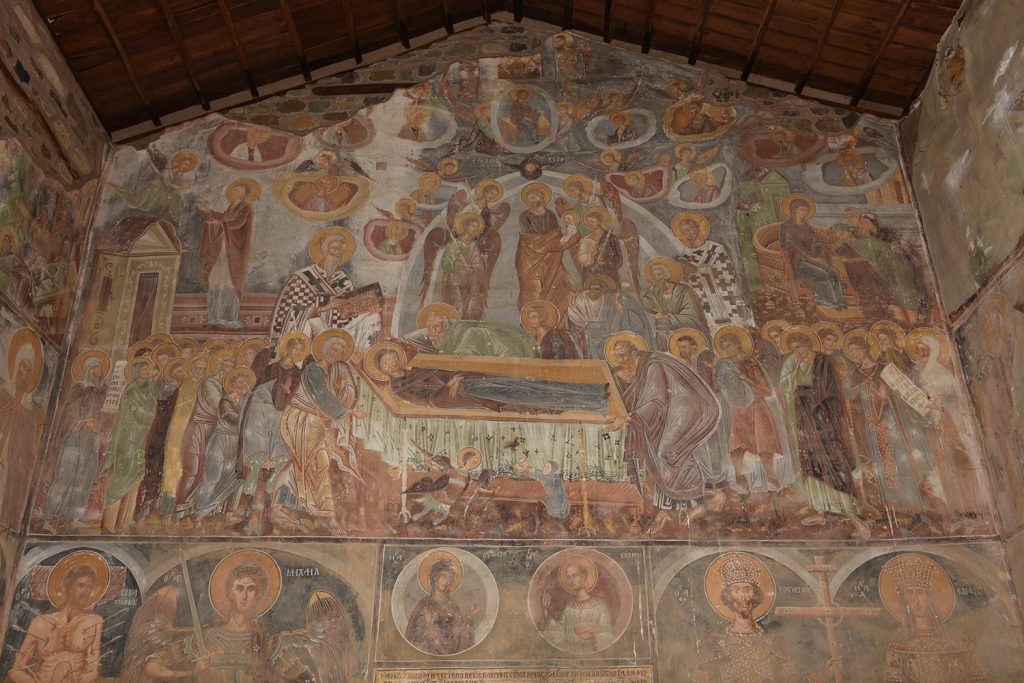
Wall paintings from St Demetrius Church, Palaticia village near Veria
Among the masters coming from the village of Linotopi the icon-painters Michael and his son Constantine were quite popular and sought after for commissions by their contemporaries. For one year and a couple of months in 1619-1620 Michael and Constantine made two mural ensembles near Ioannina: the Chruch of St. Nicholas in the village of Vitsa and the Church of St. Minas in the village of Monodendri. Their work at these churches shows that they preferred to use the models of the “Epirus school”. For instance, there is similarity in the location of the image of Christ Pantocrator in the vault surrounded by many medallions with angels and the images of the Four Evangelists, the depiction of St. Luke painting an icon of the Holy Mother of God, another detail characteristic of the Epirus school. There are repeating schemes and motives in many scenes from the Christological cycle, e.g. the Trial of Jesus before Annas and Caiaphas, the Lamentation and Entombment of Christ, the Women Myrrhbearers at the Empty Tomb of Jesus, the Harrowing of Hell, and others. Another composition typical of this 16th-century trend is also present in their repertory: Divine Liturgy, although it lacks the elegant rhythm of the figures from the preceding century. Another point continued by these icon-painters of Linotopi in the spirit of the Epirus school are the relief nimbi around the depictions of some saints. A little later on Michael and his son Constantine worked also on the territory of the old Nortern Epirus, in today’s Southern Albania and especially in the area of the diocese of Drynoupolis – Dropolis. They were very productive as between 1617 and 1653 they worked on six monuments with large-scale programs in which today we can see the trends in painting in the area back then, the preferences of the icon-painters as well as the tastes of local community.
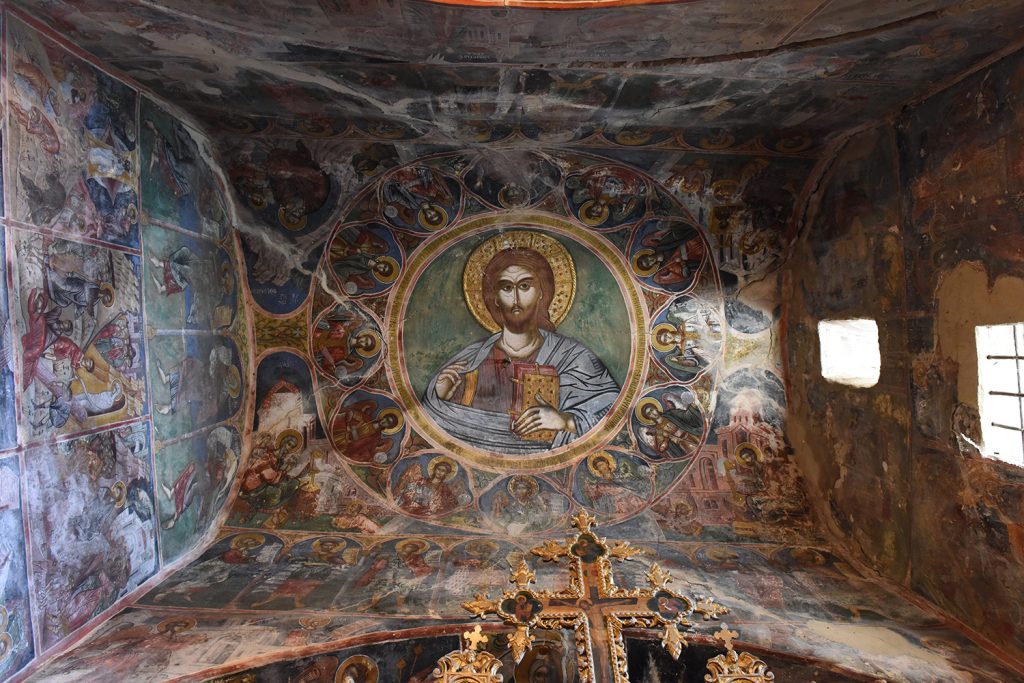
Wall paintings from the vault of the naos of St Menas Church, Monodendri village
The murals at the Church of St. Athanasius in the village of Riljevo in the district of Prilep, Macedonia reflect another artistic level. The murals date from 1627 and were made by another icon-painter of Linotopi: Ioanis, as this is one of the examples of work by an icon-painter of Linotopi in a non-Greek environment. However, these paintings are characterized by a number of failings of lines and technique.
Nikolaos of Linotopi also ranks among the more talented and able masters, alongside the icon-painters Michael and Constantine. He is a very productive icon-painter as his signature work is the murals at the Monastery of the Transfiguration in Dryovouno in the area of Kozani, again in the region of Epirus, which were created in 1652. The Katholikon of the monastery was built in 1592 but it was not until 60 years later that it was painted by using funds of monks and laymen as evident from the ktetor’s inscription. In this mural ensemble the icon-painter is in the mature phase of his creative work and his great abilities and the rich repertory of topics and images he mastered become visible here. There is a palpable link to Cretan painting as well as to the work of Michael and Constantine and the Epirus school in terms of the allocation of image. We can see a similar depiction of Christ Pantocrator, the characteristic version of Luke the Evangelist as icon-painter, the typical composition of the Crucifixion of Jesus as well as the scene of the Massacre of the Innocents. Nikolaos is among the few icon-painters of Linotopi in whose work there are influences of Western painting. For example, the specialists have noted the form of the throne of the Holy Mother of God in the scene of the Annunciation, or the scene of the Flagellation of Christ, which is directly linked to some samples of Western printing production from the preceding century: its model is the engraving of the Flagellation of Christ by Israhel van Meckenem (1445-1503). The Resurrection of Jesus is depicted in the Western manner and an echo from the principles of Western engraving can be seen in the Torment of St. Sebastian.
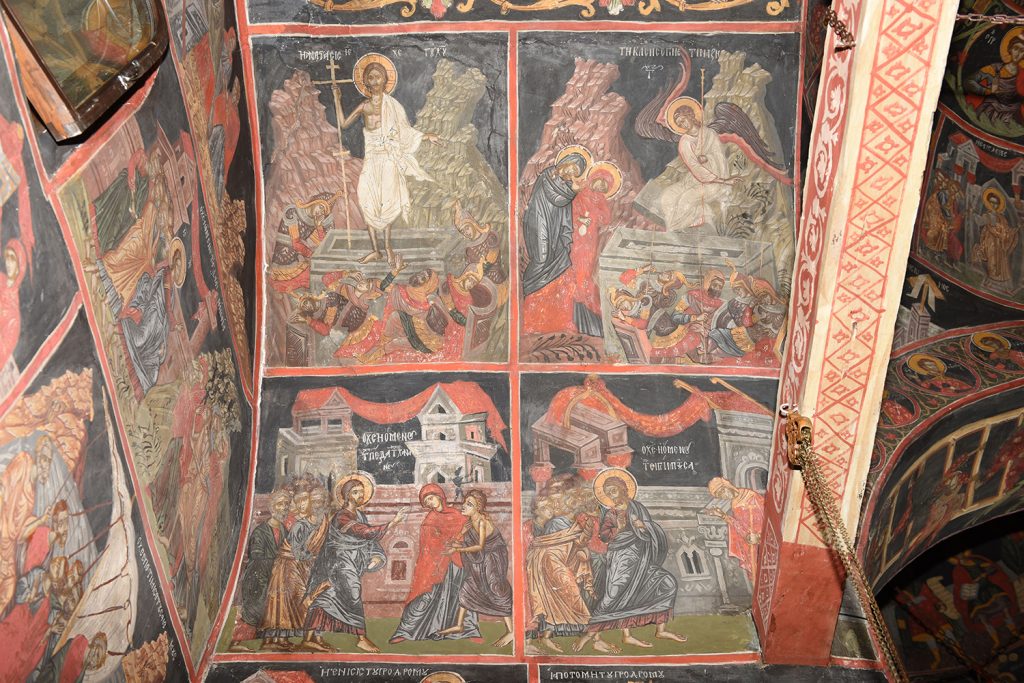
Wall paintings from the naos of the catholicon of the Holy Transfiguration Monastery, Driovouno
Several mural ensembles in other regions of the Balkans have been attributed to the icon-painter Nikolaos of Linotopi or his studio, e.g. part of the murals of the Katholikon of the Novo Hopovo Monastery in Serbia as well as a monument on Bulgarian territory, the Church of St. Athanasius in Arbanassi. There have been different hypotheses voiced so far regarding the origin of the icon-painters who painted the murals of 1667 at the church in Arbanassi: Georgi Gerov thinks that they come from the Mount Athos, Svetozara Ratseva who published a monograph on the church links them to the Epirus school. At this stage of the work under the project it can be noted that there are indeed some similarities with the work of Nikolaos of Linotopi but some additional research is still needed as regards the question concerning the more precise attribution of these murals. A more thorough study analyzing the links of the artistic production of the masters of Gramosta and Linotopi with the murals in other churches in Arbanassi is also needed, and it is to be made based on the materials collected under this scientific project.
Margarita Kuyumdzhieva
Main references
Tούρτα, Α. Οι ναοί του Αγίου Νικολάου στη Βίτσα και του Αγίου Μηνά στο Μονοδένδρι. Προσέγγιση στο έργο των ζωγράφων από το Λινοτόπι. Αθήνα, 1991.
Tourta, А. The Painters from Linotopi (Greece) and the Serbian Church. – Zbornik Matice srpske za likovne umetnosti 27-28 (1994), Novi Sad, 1994, 319-325.
Tούρτα, Α. Εικόνες ζωγράφων από το Λινοτόπι (16ος-17οςαιώνας). Νέα στοιχεία και διαπιστώσεις για τηδραστηριότητά τους. – Δελτίον της Χριστιανικής Αρχαιολογικής Εταιρίας (2001), 341-356.
Giakoumis, K. The Activity of the Painters from Linotop in the Regions of the Orthodox Church of Albania. – In: 2000 Years Church Art and Culture in Albania, eds. P. Thomo, G.Bushaka, Tirana, 2005, 229-257.
Τσάμπουρας, Θ. Το έργο του ζωγράφου Νικολάου από το Λινοτόπι στο καθολικό της Μονής Μεταμορφώσεως Δρυοβούνου.Θεσσαλονίκη, 2005.
Поповска-Коробар, В. Зографи од кругот на Јован Теодоров од Грамоста околу средината на XVI век. – В: На траговима Војислава Ј. Ђурића, Зборник радова са научног скупа одржаног у Београду 16-21. октобра. Београд, 2011, 313-324.
Τσάμπουρας, Θ. Τα καλλιτεχνικά εργαστήρια από την περιοχή του Γράμμου κατά τον 16ο και 17ο αιώνα. Ζωγράφοι από το Λινοτόπι, το Γράμμο, τη Ζέρμα και το Μπομποτσικό.PhDthesis. Θεσσαλονίκη, 2013.
